I couldn’t sleep last night, though the room was warm. I wrapped up in my sleeping bag but the mattress was hard and so after lying on one side for very long, it got sore and I’d wake up and shift. But mostly I was worried about the trek today . Getting to Namche Bazaar was a four hour hike mostly straight up til we reached an altitude of approximately 11,000 feet, not  quite as high as the Grand Teton in Wyoming, but close. I do pretty well going down hill or down steps, however dangerous they might be, and I soar on the flat areas, but uphill is tedious and there never seems to be enough breath to go with the constant lifting of my body to new heights. So I fretted during the nights and wondered if there would be hot water for a morning shower at the Mt. Kailash Lodge in Monjo. (I guess that is as close as I’ll get to the holy Tibetan mountain of Mt. Kailash, one of the destinations on this trip which has been cancelled because of angry Tibetans trying to turn the Olympics into conflict, and for which the Chinese have closed all borders into Tibet until after the Olympics.)
quite as high as the Grand Teton in Wyoming, but close. I do pretty well going down hill or down steps, however dangerous they might be, and I soar on the flat areas, but uphill is tedious and there never seems to be enough breath to go with the constant lifting of my body to new heights. So I fretted during the nights and wondered if there would be hot water for a morning shower at the Mt. Kailash Lodge in Monjo. (I guess that is as close as I’ll get to the holy Tibetan mountain of Mt. Kailash, one of the destinations on this trip which has been cancelled because of angry Tibetans trying to turn the Olympics into conflict, and for which the Chinese have closed all borders into Tibet until after the Olympics.)
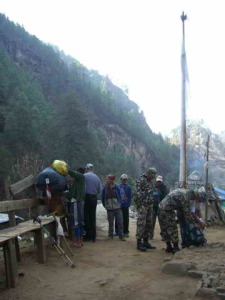 ound that out early, at 6:30 when Jeta brought me a cup of instant cappuchino which we had bought in the supermarket in Kathmandu. (I long for a frappuchino from Starbucks, but realize ice is out of the picture until the end of this trip.) There was no hot water. So I sponged bathed and as is in all cases, brushed my teeth using mineral water from a bottle. It’s so hard not to automatically pass the brush under the sink water.
ound that out early, at 6:30 when Jeta brought me a cup of instant cappuchino which we had bought in the supermarket in Kathmandu. (I long for a frappuchino from Starbucks, but realize ice is out of the picture until the end of this trip.) There was no hot water. So I sponged bathed and as is in all cases, brushed my teeth using mineral water from a bottle. It’s so hard not to automatically pass the brush under the sink water. 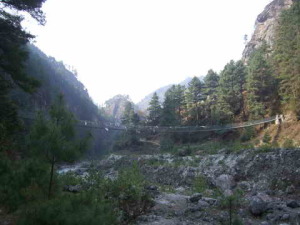 e. I wondered how anyone could run down those crude stone stairs.
e. I wondered how anyone could run down those crude stone stairs. 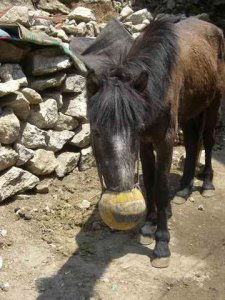 ere done with heir treks and were on the way back to Yeti Airlines. But my task was still to come. After about two hours – there are no tea houses or rest stops on the route to Namche Bazaar – we had crossed three long suspension bridges that wobble as you step on them while hanging over rowdy rivers and boulders below. Prayer flags are hung on all of them because that’s a good place to catch the wind to carry prayers to God. When we turned on yet another switchbac
ere done with heir treks and were on the way back to Yeti Airlines. But my task was still to come. After about two hours – there are no tea houses or rest stops on the route to Namche Bazaar – we had crossed three long suspension bridges that wobble as you step on them while hanging over rowdy rivers and boulders below. Prayer flags are hung on all of them because that’s a good place to catch the wind to carry prayers to God. When we turned on yet another switchbac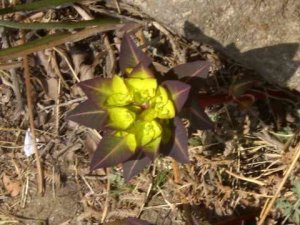 k out of the pines and rhododendron trees, and stepped into the clear morning sun, there before us was the first but hazy glimpse of Mt. Everest. It’s one tall monster of a mountain more than three times as high as we were at the moment (about 9500 feet.) Imagine that men and women climb to the top of t
k out of the pines and rhododendron trees, and stepped into the clear morning sun, there before us was the first but hazy glimpse of Mt. Everest. It’s one tall monster of a mountain more than three times as high as we were at the moment (about 9500 feet.) Imagine that men and women climb to the top of t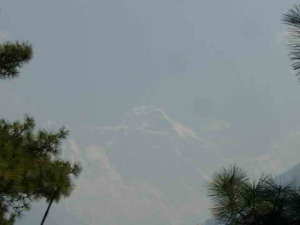 hat peak. Seems impossible. And maybe it is an invasion of what the Nepalis consider the property of God. There are so many deaths, not all of them made public. This year there are twice as many teams planning to attempt to summit Everest, but no one can do so until after May 10th, after the Olympic torch passes to the top on the China side.
hat peak. Seems impossible. And maybe it is an invasion of what the Nepalis consider the property of God. There are so many deaths, not all of them made public. This year there are twice as many teams planning to attempt to summit Everest, but no one can do so until after May 10th, after the Olympic torch passes to the top on the China side. 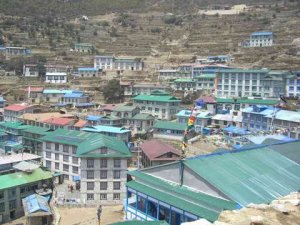 Herman Helmers Brackerie und Condetori. It was about one-fourth of the way to the top of the city where our lodge Panoramic stood. That’s about another 25 minutes of hiking straight up stairs. A rest would give us a boost. I requested a large cake donut that I had been seeing in bakery windows all along and felt good about eating it after the morning’s long skirmish. The bad news was we still had a ways to go, and the sun was hot, the wind cold, the dust flying. My Sherpa stayed with me as I slowly huffed and puffed up the crude stairs, dodging the porters passing me as if I was standing still – which at times I was – until we reached a white gate. This is it, he said. It was a good thing. I probably didn’t have enough umph for much higher. This is when the shortage of oxygen begins to set in. The red blood cells weaken, the bone marrow needs to get cracking to produce more, so we stop here to have time to re-adapt, the body being exhausted. This is why we are staying in Namche Bazaar for three nights. Acclimatize.
Herman Helmers Brackerie und Condetori. It was about one-fourth of the way to the top of the city where our lodge Panoramic stood. That’s about another 25 minutes of hiking straight up stairs. A rest would give us a boost. I requested a large cake donut that I had been seeing in bakery windows all along and felt good about eating it after the morning’s long skirmish. The bad news was we still had a ways to go, and the sun was hot, the wind cold, the dust flying. My Sherpa stayed with me as I slowly huffed and puffed up the crude stairs, dodging the porters passing me as if I was standing still – which at times I was – until we reached a white gate. This is it, he said. It was a good thing. I probably didn’t have enough umph for much higher. This is when the shortage of oxygen begins to set in. The red blood cells weaken, the bone marrow needs to get cracking to produce more, so we stop here to have time to re-adapt, the body being exhausted. This is why we are staying in Namche Bazaar for three nights. Acclimatize. 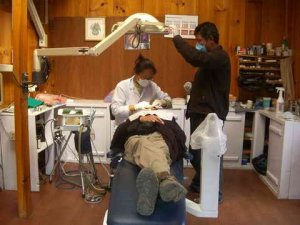 in his home in Panboche. Here I live in luxury – a room with a double sized bed, a modern toilet and a hot water shower. There is plenty of electricity here so we can recharge batteries and I can read Ken Follett’s Pillars of the Earth. This is sort of the routine, town to town. You go with what’s there.
in his home in Panboche. Here I live in luxury – a room with a double sized bed, a modern toilet and a hot water shower. There is plenty of electricity here so we can recharge batteries and I can read Ken Follett’s Pillars of the Earth. This is sort of the routine, town to town. You go with what’s there.  wall paintings and
wall paintings and 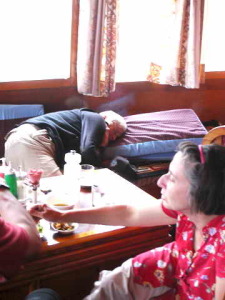 collections of holy books and a low altar of different kinds of yak butter candles, incense and silver urns all of which are thanksgiving and holy items. Six monks in red and yellow robes sat yoga-style at long tables and began to hum deeply when lunch was served to them. Most Buddhist houses have a designated sacred area or an elaborate room which the monks visit to cleanse, forgive and bless for the next year. It’s a time of horn blowing, text reading, chants and serious thought but the owners go about their business while it is going on, making sure the visitors are well-fed and attended. This must happen in every Buddhist home each year. Meanwhile, I could have used a blessing to get me back up the magnificent steps to my lodge.
collections of holy books and a low altar of different kinds of yak butter candles, incense and silver urns all of which are thanksgiving and holy items. Six monks in red and yellow robes sat yoga-style at long tables and began to hum deeply when lunch was served to them. Most Buddhist houses have a designated sacred area or an elaborate room which the monks visit to cleanse, forgive and bless for the next year. It’s a time of horn blowing, text reading, chants and serious thought but the owners go about their business while it is going on, making sure the visitors are well-fed and attended. This must happen in every Buddhist home each year. Meanwhile, I could have used a blessing to get me back up the magnificent steps to my lodge.